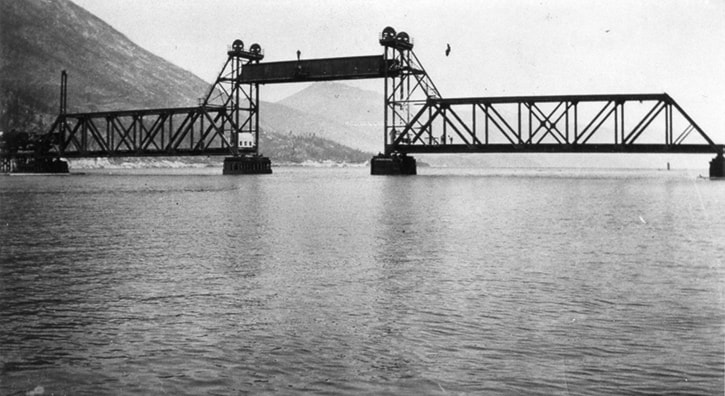Even young and tall Charlie Wilson’s weight couldn’t bring the Kootenay River railroad lift bridge back down. The expansion of the Canadian Pacific Railway line beyond Kootenay Landing, west of Sirdar, along the west side of Kootenay Lake to Nelson, necessitated building an expansive bridge over the Kootenay River where it enters Kootenay Lake.
A bridge wasn’t that big a challenge for the railroad. This early 1930s bridge was likely a lesser project compared to, say the Stony Creek Bridge. However, the bridge construction was accomplished with several sections, one of which was a lift span. This portion was a river navigation requirement. Boats, like sternwheelers, had priority on the river, so in order to maintain that, a section of this bridge had to lift up to allow passage under the bridge.
The job was done, but, oops, up popped an unexpected hitch. After the bridge was raised it didn’t want to come down. And that was even with the help of two very heavy cement counterweights connected to the lift portion by large steel cables channeled over enormous pulleys near the top of the towers. The bridge must have gotten a bit uneven in its ascent.
How they got it down, I’m not sure, but trains, perhaps eight per day, were permitted safe passage over the bridge. As far as I know, it was raised only the one time, allowing passage of the first and only boat to make use of the lift section. With the completion of the railway to Nelson, the transportation of train cars, goods and people by sternwheelers on Kootenay Lake began its demise. Boats, for a few years, did travel up and down the lake, making stops at isolated communities, mining camps and homes.
As I was thinking about the bridge span that wouldn’t immediately come down, I imagined some hapless handcar or speedy car operator unwittingly sailing into the river from the open span. It would be quite a little plunk. As far as I know, that never happened, as it was widespread knowledge — and without email — that the bridge was stuck in the up position and that it was not a profitable venture to try and jump the gap. (In other aspects of real life, some people try to do that!)
One speedy car did have an unfortunate ending, but of a different sort and place. Now, I am not sure how long it takes to put a speedy car together — a while I expect. But one can be “disassembled” in a second or less and here’s how it happened.
A few years back, a speedy car and, of course, its operator were heading along the track between Wynndel and Alice Siding. When it rounded one of the many bends in the line, it came face-to-face with an approaching locomotive. The operator, not wanting anything to do with this, leaped for the ditch, sustaining a few scratches, scrapes, shockwaves, bruises and bumps but survived the ordeal, not mentioning what may have happened in the track foreman’s office. But it’s a different story with the speedy car.
Unfortunately, although they do on occasion jump the track, it didn’t happen in this case. Needless to say, when the speeder (not the operator) connected with the front end of the locomotive, it was instantly, totally disassembled, almost smashed to smithereens (flinders) and, of course, pronounced “dead” on its arrival at numerous locations.
Railroad history is full of stories of runaway engines, cabooses and boxcars. The Creston railway yard in a reduced form still exists east of the Railway Boulevard crossing. The yard often had box cars stored on its sidings, ready to be picked up by the next train. Boxcars may have been empty, full of firewood or coal for section quarters, along the track somewhere, or heaped up with sugar beets, wheat, corn or other local produce.
Now the track from the former site of the Erickson station was very slightly downhill all the way through the Creston yard and on to Wynndel, once called Duck Creek. On this one occasion, a boxcar, which apparently didn’t have the brake set or the wheels chocked, started to roll. I think it got almost to Wynndel where it derailed without any human casualties.
All that was then, but now? There are still some stories flitting around, while some are buried under the tracks. Some of these stories and others can be relived, with a little help from one’s imagination, at the annual fall train show at the Creston Museum. Everyone is welcome at this event, which will happen 10 a.m.-4 p.m. Nov. 22. Cross the tracks at Devon Street and take a tour of “real” trains passing safely, hopefully, over the Kootenay River lift bridge and past scenic mountain landscapes. You might even get to be an engineer! All aboard!
Ed McMackin is a biologist by profession but a naturalist and hiker by nature. He can be reached at 250-866-5747.
